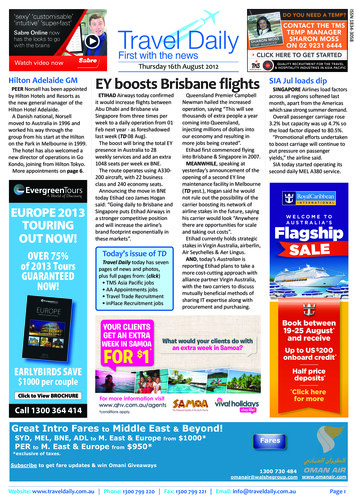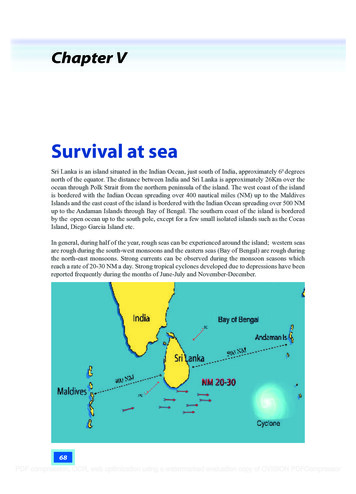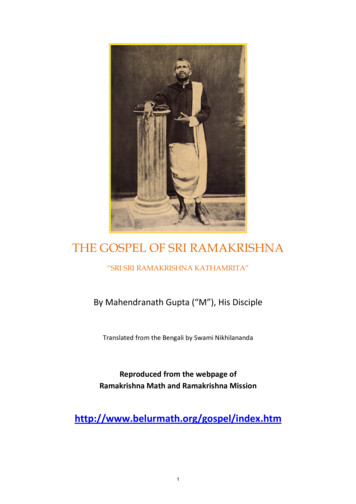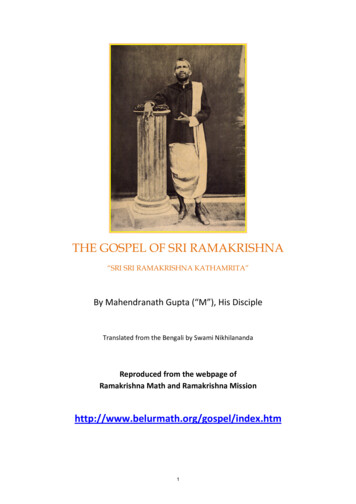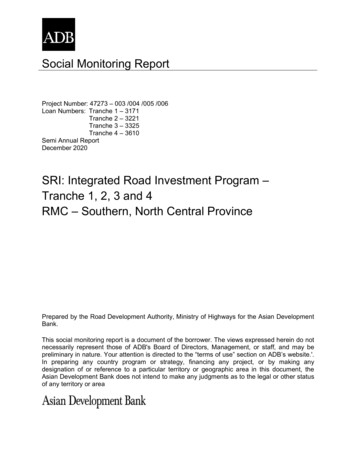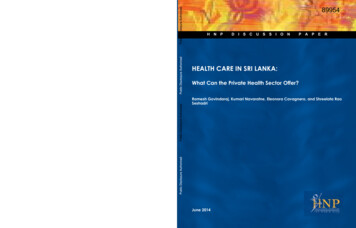
Transcription
Public Disclosure AuthorizedPublic Disclosure AuthorizedEnquiries about the series and submissions should be made directly tothe Editor Martin Lutalo (mlutalo@worldbank.org) or HNP Advisory Service (healthpop@worldbank.org, tel 202 473-2256, fax 202 522-3234).For more information, see also www.worldbank.org/hnppublications.The world bank1818 H Street, NWWashington, DC USA 20433Telephone:202 473 1000Facsimile:202 477 6391Internet: www.worldbank.orgE-mail: feedback@worldbank.orgHNPDiscussionPapeRHEALTH CARE IN SRI LANKA:What Can the Private Health Sector Offer?Ramesh Govindaraj, Kumari Navaratne, Eleonora Cavagnero, and Shreelata RaoSeshadriPublic Disclosure AuthorizedThis series is produced by the Health, Nutrition, and Population Family(HNP) of the World Bank’s Human Development Network. The papersin this series aim to provide a vehicle for publishing preliminary andunpolished results on HNP topics to encourage discussion and debate.The findings, interpretations, and conclusions expressed in this paperare entirely those of the author(s) and should not be attributed in anymanner to the World Bank, to its affiliated organizations or to membersof its Board of Executive Directors or the countries they represent.Citation and the use of material presented in this series should takeinto account this provisional character. For free copies of papers in thisseries please contact the individual authors whose name appears onthe paper.Public Disclosure AuthorizedAbout this series.89954June 2014
Health Care in Sri Lanka: What Can the Private Health SectorOffer?Ramesh Govindaraj, Kumari Navaratne, Eleonora Cavagnero, andShreelata Rao SeshadriJune 2014
Health, Nutrition, and Population (HNP) Discussion PaperThis series is produced by the Health, Nutrition, and Population Family (HNP) of the WorldBank's Human Development Network (HDN). The papers in this series aim to provide a vehiclefor publishing preliminary results on HNP topics to encourage discussion and debate. Thefindings, interpretations, and conclusions expressed in this paper are entirely those of theauthor(s) and should not be attributed in any manner to the World Bank, to its affiliatedorganizations, or to members of its Board of Executive Directors or the countries they represent.Citation and the use of material presented in this series should take into account this provisionalcharacter.For information regarding the HNP Discussion Paper Series, please contact the Editor, MartinLutalo at mlutalo@worldbank.org or Erika Yanick at eyanick@worldbank.org.i
Health, Nutrition, and Population (HNP) Discussion PaperHealth Care in Sri Lanka: What Can the Private Health Sector Offer?Ramesh Govindaraj,a Kumari Navaratne,b Eleonora Cavagnero,c and Shreelata Rao SeshadridaSASHN, The World Bank, New Delhi, IndiaSASHN, The World Bank, Colombo, Sri LankacLCSHH, The World Bank, Washington, DCdSASHN, Azim Premji University, Bangalore, IndiabAbstract: This review represents an attempt to bridge — through a systematic collection andanalysis of primary and secondary data on the provision, financing, and regulation of health careservices — the significant knowledge gaps on the private health sector in Sri Lanka, and foster adialogue on opportunities for collaboration between the government and the private sector.Key findings of the review are as follows: First, on health service delivery, the private sector inSri Lanka includes a range of providers; tends to focus primarily on the provision of curative —rather than preventive — and outpatient services; is heavily dependent on the public sector for itssupply of human resources; and is concentrated in urban areas. The quality of health careservices in Sri Lanka in both the private and public sectors, while better than in most developingcountries, still lags behind those offered in more advanced countries. There is also littlesystematic dialogue and collaboration between the public and private sectors in the delivery ofservices. Second, on financing, notwithstanding the remarkable success of the public sector inensuring access to efficient and good quality health services in Sri Lanka, private healthexpenditure is more than half of total health expenditure — mostly in the form of out-of-pocketpayments by households at the point of service delivery — with clear implications for SriLanka’s progression toward universal health coverage. Finally, on stewardship and regulation,with the growing private sector, there is a clear and urgent need to bridge the existing gaps in thelegal/regulatory framework, and in the enforcement of health regulations applicable to theprivate sector, as well as to create an enabling environment for more effective private sectorparticipation in the health sector.Overall, the review demonstrates that the private health sector in Sri Lanka is a growing force,due both to greater investment from private players — who recognize the prevailing gaps in thedelivery of public services and the evolving demographic and epidemiological profile of SriLanka — as well as greater demand from the population, including the poor — for “quicker,cleaner, and more flexible” health care services (Salgado, 2012). In this context, the studyhighlights areas related to the provision, financing, and regulation of the health sector where amore effective engagement with the private sector could ensure that Sri Lanka is able to offer itscitizens universal access to good quality health services, while also stimulating economic growth— in line with the aspirations of Mahinda Chintana, Sri Lanka’s national vision document.ii
Keywords: Sri Lanka, private health sector, public-private partnership, provision of healthservices, health expenditures, service utilization, governance and regulation.Disclaimer: The findings, interpretations, and conclusions expressed in the paper are entirelythose of the authors, and do not represent the views of the World Bank, its Executive Directors,or the countries they represent.Correspondence Details: Ramesh Govindaraj, Lead Health Specialist, South Asia HumanDevelopment, The World Bank, 70 Lodhi Estate, New Delhi - 110003, India; Telephone: 914147-9187; e-mail: rgovindaraj@worldbank.org.iii
ACKNOWLEDGMENTSThis paper was authored by Ramesh Govindaraj (Team Leader, SASHN), Kumari Navaratne(SASHN), Eleonora Cavagnero (LCSHN, formerly SASHN), and Shreelata Rao Seshadri (AzimPremji University, India). It draws on field research, data, and transcripts prepared by ColvinGunaratne (Consultant), Ravi Rannan-Eliya and team (Consultant, Institute for Health Policy, SriLanka), and Jinendra Kottalawala (Consultant, Nielson Company, Sri Lanka), under contractwith SASHN, as well as Sandya Salgado from the EXT team. The review has benefitted greatlyfrom the support of staff from other sectors, including PREM, FIPSI, and EXT. The assistanceprovided by Sundararajan S. Gopalan (formerly SASHN, Sri Lanka), Rabia Ali and Owen Smith(both SASHN) in reviewing and commenting on the document, and the support provided byAjay Ram Dass in formatting the document, is gratefully acknowledged. The study has hadconsistent support from Darietou Gaye, CD for Sri Lanka and the Maldives, Julie McLaughlin,Sector Manager, South Asia Health, Nutrition, and Population Department and from KeesKostermans, Lead Health Specialist, which is gratefully acknowledged. The useful commentsprovided at various stages by the three peer reviewers, April Harding, Daniel Cotlear, and Dr.Saroj Jayasinghe — Professor, Colombo Medical College — are also acknowledged. Finally, theauthors are grateful to the private and public sector stakeholders who served as studyrespondents, and to the officials of the Ministry of Health, who were cosponsors of the study andwithout whose cooperation this review would not have been possible.iv
Table of ContentsACKNOWLEDGMENTS . IVABBREVIATIONS AND ACRONYMS . VIISECTION I. INTRODUCTION . 11.11.21.31.41.5Background . 1Rationale . 1Objectives and Scope . 3Sources and Methods . 3Audience . 4SECTION II. VOICES: PATIENT AND PROVIDER PERCEPTIONS . 6SECTION III. THE PROVISION OF HEALTH SERVICES . 93.13.23.3The Public and Private Sectors: How Big Are They and What Do They Do?. 9Public Health Care Provision. 9Private Health Care Provision . 10SECTION IV. HEALTH EXPENDITURES AND UTILIZATION OF HEALTHSERVICES . 254.14.24.3Total Health Expenditure. 25Public Financing . 26Private Financing . 28SECTION V. GOVERNANCE AND REGULATION . 365.15.25.3The Law Relating to the Regulation of Private Medical Institutions. 36Gaps in the Legislative Framework, Implementation, and Enforcement . 37Implementation/Enforcement of Government-Mandated Reporting . 38SECTION VI. CONCLUSIONS AND THE WAY FORWARD . 40List of BoxesBox 2.1 Health Seeking Behavior of Sri Lankans vis-à-vis Private Providers . 6Box 2.2 Private Sector Perceptions on Government Regulation and Public-Private Collaboration. 7v
List of FiguresFigure 3.1 Year of Establishment of Private Health Facilities Surveyed . 11Figure 3.2 Distribution of Private Hospitals in Sri Lanka 2011 . 11Figure 3.3 Diffusion of High-Technology Equipment in Private Hospital Sector, 1990–201115Figure 3.4 Barriers and Obstacles Faced by Hospitals for Successful Business Operation . 17Figure 4.1 Total Health Expenditure in Sri Lanka by Source of Financing . 25Figure 4.2 Out-of-Pocket Health Payments (by Expenditure Quintiles), 2010 . 29Figure 4.3 Structure of Out-of-Pocket Health Payments (by Income Quintile) 2009–10 . 31Figure 4.4 Distribution of Catastrophic Expenditures and Impoverishment (across Quintiles)2010. 32Figure 4.5 Trends in Premiums and Claims for Private Medical Insurance in General InsurancePortfolio (Rs. million), 2000–11 . 35List of TablesTable 3.1 Key Public and Private Sector Statistics (2011) . 9Table 3.2 Availability of the Types of Specialized Hospital Beds in the Private Health Sector(N 82) . 12Table 3.3 Sources of Revenue to Private Health Facilities Surveyed. 13Table 3.4 Factors Determining Private Sector Utilization . 15Table 3.5 Quality Indicators for Patients Admitted with Acute Asthma . 19Table 3.6 Quality Indicators for Patients Admitted with AMI . 19Table 3.7 Quality Indicators for Patients Admitted for Childbirth . 20Table 3.8 Process Quality Indicators from Observational Interviews, by Sector . 21Table 3.9 Patient Satisfaction Quality Indicator Outcomes, by Sector. 23Table 4.1 Share of Health Expenditure for Each Function, by Source of Finance (Percent), 1990–2009. 27Table 4.2 Health Expenditure as a Share of Household Total Expenditure . 28Table 4.3 Health Expenditure as a Share of Household Nonfood Expenditure by Poverty . 29Table 4.4 Composition of Out-of-Pocket Expenditure Capita. 30Table 4.5 Catastrophic Payments at Different Thresholds, 2010 . 32Table 4.6 Catastrophic Expenditures and Impoverishment due to OOPE, 2002–10 . 32Table 4.7 Utilization Rates of Outpatient Services, Sri Lanka — 2006 and 2010 . 33Table 4.8 Reasons for Utilization of Inpatient Services, Sri Lanka — 2006 and 2010 . 33Table 4.9 General and Life Health Insurance Premiums and Claims, 2011 . 34Table 5.1 Current Practices with Regard to Data Reporting to a Government Agency . 38Table 5.2 Record Systems Maintained by Private Health Facilities . 38vi
ABBREVIATIONS AND DHSPHIPHNSPHSRCPMIRAPPPSLHASPHISPHMTHEAuthorized OfficerDeputy Director GeneralGross Domestic ProductGovernment of Sri LankaIntensive Care UnitMinistry of Finance and PlanningMinistry of HealthMedical Supplies DepartmentNon Communicable DiseaseNongovernment OrganizationOut-of-Pocket ExpenditureOutpatient DepartmentPolymerase Chain ReactionProvincial Director of Health ServicesPublic Health InspectorPublic Health Nursing SistersPrivate Health Services Regulatory CouncilPrivate Medical Institutions Registration ActPublic-Private PartnershipSri Lankan Health AccountsSupervising Public Health InspectorSupervising Public Health MidwivesTotal Health Expenditurevii
SECTION I. INTRODUCTION1.1BackgroundSri Lanka has made remarkable progress in improving the health status of its population. Sincethe 1920s (Gottret and Schieber 2009), the country has made dramatic strides on key outcomeindicators such as life expectancy (75.9 years at birth in 2012 compared to 40.0 in 1930) andchild mortality (17 per 1,000 in 2010, down from 175 in 1930) (CIA World Factbook andUNICEF, 2012). Sri Lanka’s achievement is even more remarkable when we consider its level ofincome and its low expenditure on health. It spends a total (public and private) of approximately4.2 percent of GDP or US 57 per capita on health (Sri Lanka Health Accounts [SLHA] 2011).Yet, many of its health indicators are comparable to those found in Thailand, Malaysia, andKorea — countries with income levels two to six times higher, adjusting for purchasing powerparity, which spend 1.5 to 10.0 times more on health per capita.The Sri Lankan model relies heavily on an effective public delivery system, providing bothpreventive and curative care with separate dedicated teams for each of these streams. Contrary tothe experience of most other countries in South Asia, empirical evidence indicates that the publicsector in Sri Lanka has delivered care at low cost with high levels of productivity and efficiency(Hsiao, 2000). One reason for such efficiency might be the strong focus on the inherently morecost-effective preventive and public health services, along with a reasonable level of access tocurative services.1.2RationaleWhile the public sector in Sri Lanka has been remarkably successful in ensuring access toefficient and good quality health services, gaps in the system — such as in the provision ofcurative care — have persisted. The private sector has stepped in to fill these gaps in curativeservices in a variety of ways: specialty hospitals catering to the rich, private practitioners (manyof whom are also working in the public sector), and a thriving business of private pharmaciesand investigative services that cater to rich and poor alike. It is estimated that the private sectorin Sri Lanka accounts for 50 percent of total health expenditure. Although this is reason enoughto conduct this review, there are several other important reasons, particularly with an eye on thefuture and given the evolving challenges in the health sector. Greater purchasing power increases demand for private health services: Sri Lanka is now amiddle-income country. With increasing purchasing power, private health care options —with their perceived benefits of “quicker,” “cleaner,” and “more flexible” service delivery(Salgado, 2012) — are expanding. This expansion of options, combined with the gaps inservice delivery and quality in the public system noted above, suggest that the demand forprivate options for health care may be a growing trend. Demographic and epidemiological transitions pose new health challenges: Sri Lanka isnow at a crossroads: due to the marked increase in life expectancy and decrease in fertilityrates, the country is in the advanced stages of a demographic and epidemiological transition.1
With the share of the population age 60 years and older expected to double in the next 30years to 24 percent, it faces the challenge of an aging population. There is also a shift in thedisease profile, with non-communicable diseases (NCDs) now accounting for 85 percent ofthe total burden of disease (Government of Sri Lanka 2011). Servicing the needs of theelderly, as well as treating and managing NCDs, requires longer-term and more expensiveservices relative to maternal and child health and infectious disease interventions. Increasing NCD burden risks exacerbating inequalities in health care access: The poorbecome particularly vulnerable as the incidence of NCDs rises. This is likely to mean out-ofpocket payments for needed medicines and investigative services, which are both costlier andrequire sustained usage. There is a real risk that this trend could compromise Sri Lanka’sstellar record in protecting the poor against catastrophic and impoverishing healthexpenditures. The evidence-base for the private sector in health is weak: Despite the stronginterrelationship between the public and private sectors, the private sector is generally notwell understood by policy makers. The paucity of information is an important reason for thesuboptimal participation of the private sector in the achievement of public health objectives;in fact, prior to this review, no systematic assessment of the private health sector had beenundertaken in Sri Lanka. Both the public and private sectors now see value in engaging with each other: TheMahinda Chintana — the government’s vision document for 2011–16 — has spelled out thecountry’s aspirations in the health sector. In the recent past, there has been an increasingrecognition within the Ministry of Health (MoH) and in the Ministry of Finance and Planning(MoFP) of the imperative of engaging with the private sector to achieve these aspirations. Atthe same time, there appears to be considerable interest on the part of private sector actors topartner with the government for mutual benefit. This is therefore an opportune time to fostera discussion on the joint provision of services at an affordable cost, with better regulation ofquality across the sector.In sum, even as Sri Lanka aspires to improve the quality of existing health care and transform thesector into one that caters to economic growth as well as to social inclusion, the country facesfresh challenges posed by the aging population and the growing burden of NCDs. This clearlywarrants fresh thinking on how to finance and deliver health services in the future. As the publicsystem in Sri Lanka is quite well documented, there was widespread agreement amongstakeholders in the health sector and beyond, including the MoH, the MoFP, and opinion leadersin the private sector, that future reforms of the health system would benefit from analytical workthat sheds light on the current functioning of the private sector and ways in which it couldcontribute to public sector goals. Accordingly, an agreement was reached with the governmentthat this review of the private health sector would be undertaken by the World Bank, in closeconcert with the Private Sector Development Unit within the MoH.2
1.3Objectives and ScopeThe overall objectives of this review are to better understand the private health sector in SriLanka, particularly its financing, provision, and regulation, and to foster a dialogue onopportunities for increased collaboration between the government and the private sector. Thereview seeks to achieve these objectives by engaging in the following: Improving the evidence-base on the characteristics of private provision of health careservices and the use of medicines;Deepening the current understanding of the nature of private expenditures in the context ofthe overall utilization and financing for health; andClarifying certain aspects of the interaction between the public and private sectors, includinggovernment regulation of private providers, as well as the perceptions of the public sectorabout the private sector and vice versa.Conscious choices had to be made to limit the scope of this review, given data, resource, andtime constraints, as well as the complexity of the private health sector. In particular, whilerecognizing the importance of such issues, the review does not include a comprehensivetreatment of alternative health providers, medical equipment, hygiene products, and other suchhealth-related commodities. A detailed assessment of the consumer perspective, of labor marketissues, and of public-private partnership opportunities was not feasible in this review, but theseare important areas for follow-up assessments. Finally, a fiscal space analysis, an analysis ofcosts and prices in the public/private sectors, and an in-depth assessment of the investmentclimate and business environment for private sector participation in the health sector are beyondthe scope of this review.1.4Sources and MethodsThe paper draws upon the existing published and grey literature, as well as the following studiesthat were undertaken as a part of this private sector review: 1 Quality of Healthcare Services in Public and Private Health Facilities in Sri Lanka: Thisstudy assessed the quality of care in the public and private sectors in Sri Lanka. For assessingthe quality of inpatient care, the study looked at process quality, that is, what providersactually do. The approach included a retrospective review of patient medical records and ananalysis of care using tracer conditions. For outpatient care, both process quality and thequality of outcomes were assessed through observation of patient consultations, followed byan exit interview of the patient. An analysis of care using tracer conditions and generalindicators was also undertaken. Criteria for selecting the three tracer conditions (acutemyocardial infarction, acute asthma, and childbirth) were (i) the frequency of the conditions;(ii) the existence of viable quality indicators, with support in the literature; and (iii) theirrepresentativeness over a range of conditions and patient populations. The survey wasconfined to three districts for reasons of cost and time.1. Summaries of all background studies are provided in annex 1.3
A Private Health Sector Facility Mapping in Selected Areas of the North Western Provincewas undertaken utilizing geographic information system (GIS) technology and providing adescription of private health sector facilities in four Divisional Secretary areas of the NorthWestern Province. The objective of the mapping was to better understand the existingdistribution of private health facilities in relation to public facilities, to improve the interlinkages between these facilities and expand the range of options available to people seekinghealth services. The exercise mapped and photographed private health service points;described the private health facility’s current registration status with the Ministry of Healthor any other authority; and identified geographical relationships between private and publichealth facilities. This exercise also facilitated an assessment of the reliability of theinformation on private health facilities collected by the MoH. A Selected Private Health Sector Review: This study profiled selected dimensions of privatehealth sector activity using, among other sources, information from Private Health ServicesRegulatory Council (PHSRC) licensing data, the IMS-Health Database, survey data from theInstitute for Health Policy (IHP) Private Hospitals Database, the Sri Lanka SLPA, the MoH,the Medical Supplies Department (MSD), and the Consumer Finance Survey (CFS) 2004. Management Practices Survey in the Health Sector: As part of this review, an assessment ofmanagement practices in the private health sector was conducted for the first time in SriLanka from June to November 2011, using a globally accepted methodology developed bythe World Bank Group. The objective of the structured questionnaire-based survey was tounderstand the private health sector in terms of its type, size, level of services, and facilities. Analysis of Household Health Expenditures in Sri Lanka: Impacts and Trends: This analysisexamined out-of-pocket expenditures (OOPEs) and catastrophic expenditures by incomequintiles and type of health care provider. The analysis drew upon the Household Income andExpenditure Surveys 2002, 2007, and 2010 (Department of Census and Statistics) andrepresentative data at provincial and national levels. The study analyzed the burden of OOPEbased on this data; catastrophic expenditures (measured as expenditures that exceed apredefined fraction of household income); as well as expenditures that impoverishedhouseholds, pushing them below the national poverty line. Review of Regulations Governing Provision of Health Care in the Private Sector in SriLanka: This review examined existing legislation and regulations to identify gaps in thelegislative framework, and assess how well the existing legislation and regulations werebeing enforced or implemented. It also recommended steps to enhance the existing regulatoryframework and explored the potential for public-private partnerships in health.1.5AudienceThe audience for this work includes the following:(i) Policy makers in the MoH and MoFP and provincial authorities responsible for formulating,financing, and implementing Sri Lanka’s health sector strategy;4
(ii) Domestic and international stakeholders, including development partners, with an interest inthe Sri Lankan health sector; and(iii) Private sector leaders, particularly those interested in partnerships with the public sector, aswell as investors with an interest in the private health sector in Sri Lanka.It is our hope that the review will serve as a stepping stone toward a common understanding ofthe issues and will foster a policy dialogue that might lead to an agreed way forward on privatesector participation in the health sector.The rest of the paper is organized as follows: Section 2 provides a snapshot of patientperceptions of health care services and health-seeking behavior in the private sector; section 3describes the provision of selected products and services in the private sector; section 4 reviewstrends in the magnitude and distribution of household out-of-pocket expenditure on health, andthe utilization of privately provided health care; section 5 describes the regulatory frameworkthat governs private health sector service delivery and quality standards; and section 6 providesoverarching conclusions and, as a starting point for a public-private policy dialogue, identifiesoptions for tapping into the potential of the private sector to contribute to public sector goals.5
SECTION II. VOICES: PATIENT AND PROVIDER PERCEPTIONSTo set the context for the analysis presented in subsequent sections of this paper, we firstexamine the voices of two critical stakeholders in the provision and utilization of health services:patients and private sector health care providers.2.1.Voices of the PeopleTo get a quick sense of the issues that were of immediate concern to Sri Lankans while choosingbetween public and private provision of health services in Sri Lanka, responses were elicited atthe beginning of this review from approximately 100 males and females belonging to differentsocial classes and geographic locations. Overall, the respondents spoke about three broad issues:health-seeking behavior, health-related expenditure, and attitudes and perceptions toward publicand private health services in the country. These responses are summarized in box 2.1 below.Box 2.1 Health-Seeking Behavior of Sri Lankans vis-à-vis Private ProvidersPerceived quality of public health services: The group had a favorable view of public health services on severalcounts: universal access to health services for all Sri Lankans, irrespective o
expenditure is more than half of total health expenditure mostly in the form of out— -of-pocket payments by households at the point of service delivery with clear implications for Sri — Lanka's progression toward universal health coverage. Finally, on stewardship and regulation,





